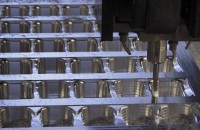12/03/2014
Zirbs
Zirbs
Packaging from Zirbs: Individual, Secure and Attractive
Whether pralines, chocolates or cookies – all of this confectionery should be held safe and sound in a packaging tray, which should also look appealing. The Zirbs company, based in Neuhaus, has specialised in exactly this type of tray.
Whether pralines, chocolates or cookies – all of this confectionery should be held safe and sound in a packaging tray, which should also look appealing. The Zirbs company, based in Neuhaus, has specialised in exactly this type of tray.
“Our niche is small and medium-sized runs. We don’t stop where others begin, but we offer solutions that others wouldn’t even consider”, explains Martin Zirbs, who has run the company since 1995 together with his wife, Heike. It’s a strategy that’s proven very successful. Zirbs is growing: in 2013 the company generated 3.3 million euros in sales with 49 employees and around 5,000 m² of production space.
Each year, Zirbs produces around 100 million units through thermoforming for customers in the confectionery and other branches. The company’s extreme flexibility is one of its strengths. It has its own mould design and construction, enabling it to create custom trays to the customer’s specifications. Silke Jäger, responsible for product design and prototype construction, explains that, “we visit our customers at their location and discuss what they need. On one hand, the trays should be appealing, while on the other the product must also be protected.” This means that trays are often individually designed to achieve the desired presentation and packaging. It should also highlight the diverse praline shapes, which are becoming increasingly more unique. As a result, approximately 200 – 250 new shapes are created each year, and these are often used for several years at a time. The Zirbs portfolio now encompasses several thousand shapes, with a large share of readily available standard trays. Most of the forms are reserved exclusively for prominent manufacturers from all branches of the sweets industry.
The majority of new samples are created in spring. From initial concept to final packaging insert, the process usually lasts around 3 to 4 weeks, explains Jäger. In doing so, Zirbs demonstrates an extraordinary flexibility, which doesn’t stop at creating models. The construction of the thermoformed units takes place with state of the art 3D hybrid technology, and the customer can get an initial visual impression of the new packaging. Subsequently, the initial sample tool can be created utilising CAD/CAM. Then packaging investigations and physical reviews begin – at this point, the fine details are worked out until the form meets the customer’s expectations. Technical details also play a major role, as not all producers pack their products by hand, but rather on automated packaging lines. As such, these trays must not only look good, they must also meet a number of technical criteria.
Once the model has been accepted by the customer, Zirbs creates the tool. They accomplish this using either data they have created themselves from the initial sample tool or from data that the customer has made available from external developers. Zirbs uses two CNC milling machines, which use the latest HSC technology to create aluminium form tools in outstanding quality. Currently the company runs two and three shifts on multiple automated thermoforming machines. “The first thermoforming machines were put into operation at Zirbs at the end of the 1950s. The company has many years of experience in producing thermoformed units. Additional know-how and positive synergy was gained through the 2003 takeover of certain areas of the Lucas Verpackungen packaging company based in Erkelenz as well as the 2013 affiliation with the Langa Deutschland GmbH company based in Dusseldorf. Zirbs has established itself as a provider in the confectionery market. “We’ve found ourselves a noteworthy market position in our niche”, says Martin Zirbs. Around 70% of production today comes from confectionery trays, 20-25% from contract packaging for health care products, and 5-10% from thermoformed units for various areas of application.
The fully-automated thermoform machines are set up for production runs of various quantities. In 2012 they invested in new equipment that, besides standard trays, is also very efficient at producing packaging displays, sales aids, and large-format Advent calendar inserts. This makes Zirbs flexible and also enables the production of small and medium-sized production runs. The plastic foil used in this modern packaging is made of eco-friendly plastics and meets the strict guidelines of European food law. For years, the company has trusted in the abilities of the SGS Institut Fresenius for migration inspections. “As SGS confirmed to us then, we were pioneers and one of the first companies to undergo SMP (specific migration inspections)”, says Martin Zirbs. The company follows BRC regulations and since 2008 has been successfully HACCP certified on multiple occasions by TÜV Thüringen, thereby authorised to manufacture packaging for direct food contact according to EU ordinances per the LfmGb law and Foodstuffs and Commodities Act. Additional certifications are currently in the works.

